小学语法汇总
小学英语语法知识总结6篇

小学英语语法知识总结6篇英语语法是针对英语语言进行研究后,系统地总结归纳出来的一系列语言规则。
英语语法的精髓在于掌握语言的使用。
那么具体该如何总结呢?下面是为大家整理的小学英语语法知识总结6篇,希望大家能有所收获。
小学英语语法知识总结1一般过去时态(a) be 动词的过去式:I/He/she/it was(not)…. You/we/they were….一般疑问句was, were 放在句首。
(b) 动词过去式:肯定句:I watched cartoons.She visited the zoo.一般疑问句:Did you read book last night? Yes, I did. No, I didn’t.Did she clean the desk just now? Yes, she did. No, she didn’t.否定句:They didn’t go the the part yesterday.He didn’t make model ships last week.动词过去式变化规则:1.一般在动词末尾加-ed,如:pull-pulled, cook-cooked2.结尾是e加d,如:taste-tasted3.末尾是辅音字母加一个元音字母和一个辅音字母的重读闭音节,应双写末尾的辅音字母,再加-ed,如:stop-stopped4.以“辅音字母+y”结尾的,变y为i,再加-ed,如:study-studied5.不规则动词过去式:am,is-was,are-were,do-did,see-saw,say-said,give-gave,get-got,go-went,come-came,have-had,eat-ate,take-took,run-ran,sing-sang,put-put,make-made,read-read,write-wrote,draw-drew,drink-drank,swim-swam,sit-sat小学英语语法知识总结2动词加ing的变化规则1.一般情况下,直接加ing,如:cook-cooking2.以不发音的e结尾,去e加ing,如:make-making, taste-tasting3.如果末尾是辅音字母加一个元音字母和一个辅音字母,双写末尾的辅音字母,再加ing,如:run-running, stop-stopping 现在进行时,用来表示正在进行或发生的动作。
小学语法要点梳理(完美版)
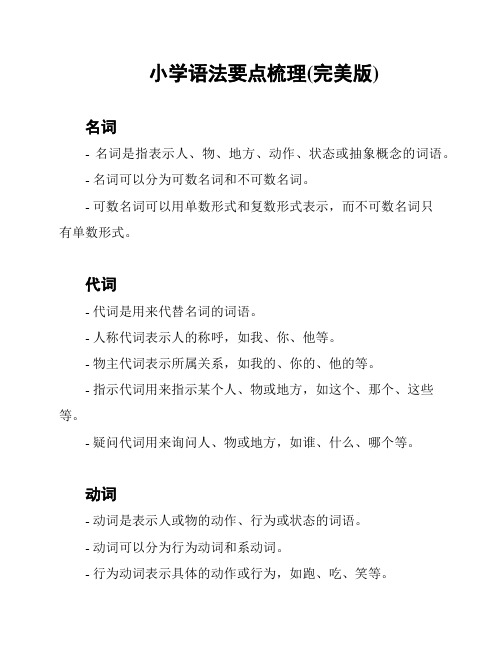
小学语法要点梳理(完美版)名词- 名词是指表示人、物、地方、动作、状态或抽象概念的词语。
- 名词可以分为可数名词和不可数名词。
- 可数名词可以用单数形式和复数形式表示,而不可数名词只有单数形式。
代词- 代词是用来代替名词的词语。
- 人称代词表示人的称呼,如我、你、他等。
- 物主代词表示所属关系,如我的、你的、他的等。
- 指示代词用来指示某个人、物或地方,如这个、那个、这些等。
- 疑问代词用来询问人、物或地方,如谁、什么、哪个等。
动词- 动词是表示人或物的动作、行为或状态的词语。
- 动词可以分为行为动词和系动词。
- 行为动词表示具体的动作或行为,如跑、吃、笑等。
- 系动词表示主语的状态或性质,如是、看起来、变成等。
形容词- 形容词是用来描述名词或代词的特征、性质或状态的词语。
- 形容词通常位于名词前面,用来修饰名词或代词。
- 形容词通常可以用比较级和最高级来表示不同程度的性质或状态。
副词- 副词是用来修饰动词、形容词、副词或整个句子的词语。
- 副词可以表示时间、地点、原因、方式、程度等不同的意义。
- 副词通常位于动词、形容词或副词之前,用来修饰它们。
介词- 介词是用来表示名词或代词与其他词之间关系的词语。
- 介词通常位于名词或代词之前,连接名词或代词与其他成分。
连词- 连词是用来连接词与词、短语与短语或句子与句子的词语。
- 有并列连词、递进连词、选择连词、对比连词等不同类型的连词。
冠词- 冠词是一种特殊的限定词,用来限定名词。
- 冠词分为定冠词和不定冠词。
- 定冠词表示特指的名词,如the。
- 不定冠词表示泛指的名词,如a和an。
句子- 句子是用来表达完整意思的一组词语。
- 句子可以分为陈述句、疑问句、命令句和感叹句。
- 句子由主语和谓语组成,可以包含其他成分。
时态- 时态是表示动作发生的时间的形式。
- 英语有过去时、现在时和将来时等不同的时态。
- 按照具体语境选用适当的时态以表达正确的时间关系。
小学英语语法大全(完整版)(可打印)
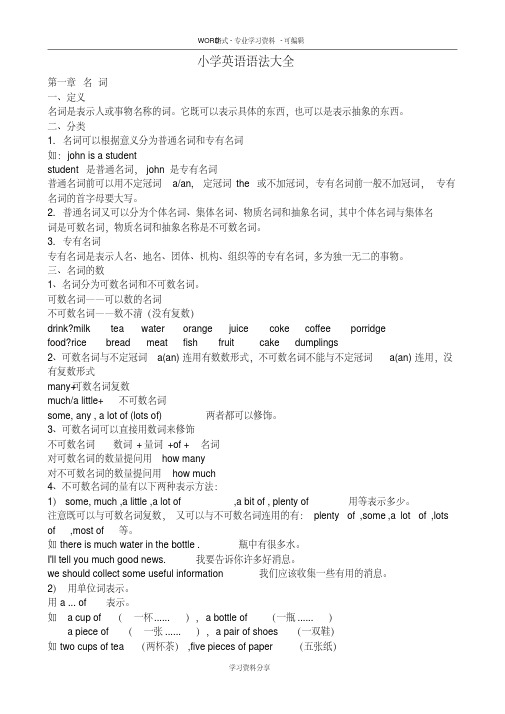
小学英语语法大全第一章名词一、定义名词是表示人或事物名称的词。
它既可以表示具体的东西,也可以是表示抽象的东西。
二、分类1. 名词可以根据意义分为普通名词和专有名词如:john is a studentstudent是普通名词,john是专有名词普通名词前可以用不定冠词a/an, 定冠词the 或不加冠词,专有名词前一般不加冠词,专有名词的首字母要大写。
2. 普通名词又可以分为个体名词、集体名词、物质名词和抽象名词,其中个体名词与集体名词是可数名词,物质名词和抽象名称是不可数名词。
3. 专有名词专有名词是表示人名、地名、团体、机构、组织等的专有名词,多为独一无二的事物。
三、名词的数1、名词分为可数名词和不可数名词。
可数名词——可以数的名词不可数名词——数不清(没有复数)drink?milk tea water orange juice coke coffee porridgefood?rice bread meat fish fruit cake dumplings2、可数名词与不定冠词a(an)连用有数数形式,不可数名词不能与不定冠词a(an)连用,没有复数形式many+可数名词复数much/a little+不可数名词some, any , a lot of (lots of) 两者都可以修饰。
3、可数名词可以直接用数词来修饰不可数名词数词 +量词 +of + 名词对可数名词的数量提问用how many对不可数名词的数量提问用 how much4、不可数名词的量有以下两种表示方法:1) some, much ,a little ,a lot of ,a bit of , plenty of 用等表示多少。
注意既可以与可数名词复数,又可以与不可数名词连用的有:plenty of ,some ,a lot of ,lots of ,most of 等。
如there is much water in the bottle .瓶中有很多水。
(完整版)小学最全英语语法汇总
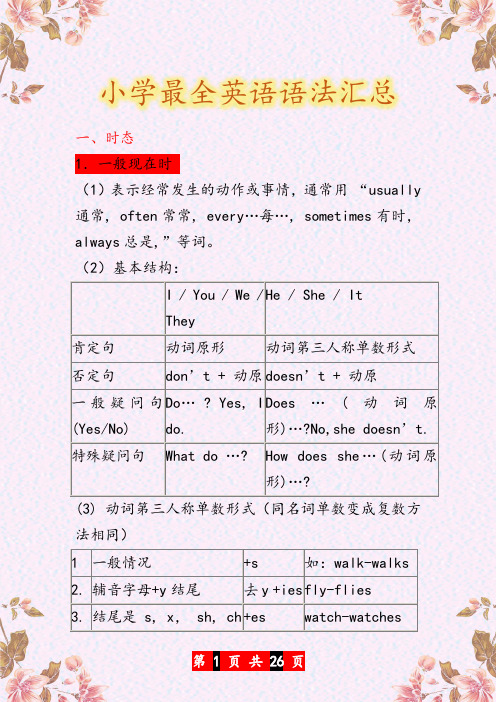
小学最全英语语法汇总一、时态1.一般现在时(1)表示经常发生的动作或事情,通常用“usually 通常, often常常, every…每…, sometimes有时,always总是,”等词。
(2)基本结构:I / You / We /TheyHe / She / It肯定句动词原形动词第三人称单数形式否定句don’t + 动原doesn’t + 动原一般疑问句(Yes/No) Do… ? Yes, Ido.Does…(动词原形)…?No,she doesn’t.特殊疑问句What do …? How does she…(动词原形)…?(3) 动词第三人称单数形式(同名词单数变成复数方法相同)1 一般情况+s 如:walk-walks2. 辅音字母+y结尾去y +ies f ly-flies3. 结尾是 s, x, sh, ch +es watch-watches4.特殊的do-does ,have-has, go-goes2.现在进行时,(1)表示正在发生的动作,通常用“now现在, look 看,linsen听”.(2)基本形式: be + 动词ingeg: I am(not) doing my homework.You/We/They are(not) reading.He/She/It is(not) eating.What are you doing?Is he reading?(3)动词的现在分词形式(动词+ing)一般情况+ing walk—walking结尾是不发音的 e -e +ingcome—coming重读闭音节双写最后一个字母+ing run-running swim-swimming3. 一般过去时(1)表示过去已经发生的事情,通常用“last …上一个…, just now刚才, a moment ago刚才,yesterday 昨天”等词。
(2) be 动词的过去式: am/is —was are —were(3)过去式基本结构 肯定句(Positive )动词过去式 I went shopping lastnight. 否定句(Negative) Didn ’t + 动词原形I didn ’t go shoppinglast night. 一般疑问句(Yes/No) Did …+ 动词原形…? Did you go shopping last night?特殊疑问句(wh-) What did …+ 动词原形…? What did you do last night?(4)词过去式的变化:规则动词的变化:一般动词 +ed planted,watered,climbed以不发音的e 结尾+d liked 辅音字母加y 结尾 -y+ ied study —studied,cry- cried重读闭音节单词,末尾只有一个辅音字母 双写最后一个字母+edstop –stopped plan - planned不规则动词的变化:原形 过去式 原形 过去式 原形 过去式 原形 过去式sweep swept t each taught have had go wentkeep kept think thought do did find foundsleep slept b uy bought eat ate say saidfeelfelt drink drank is/am w as take took readread give gave are were mean meant putput sing sang drive d rove meet met cutcut begin began speak s poke make made letlet ring rang write w rote see saw flyflew run ran ride rode come came drawdrew sit sat hear heard tell told grow grew learn learned/ learntget got know knew 4.一般将来时一般将来时表示将来打算做的事或将要发生的事情。
小学语文语法知识大全
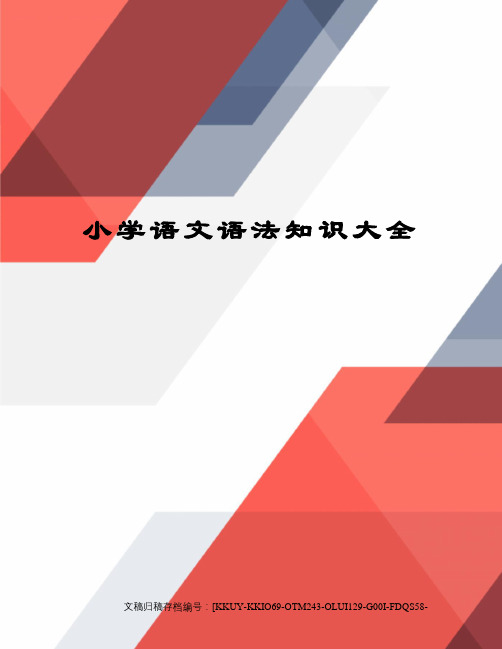
小学语文语法知识大全文稿归稿存档编号:[KKUY-KKIO69-OTM243-OLUI129-G00I-FDQS58-(一)关联词(de)使用关联词(de)意义能够把两个或者两个以上在意义上有密切联系(de)句子连接起来组成比较复杂(de)句子(de)词语,就是关联词语.恰当(de)使用关联词语,能使我们在说话或者协作时达到较好(de)表达效果.并列关系:两个分句之间(de)关系相互并列.每个分句各说一件事或同一事件(de)一个方面.既…又… 一边…一边… 又…又… 一面…一面…不是…而是… 有时…有时… 一会儿…一会儿… 那么…那么…小芳既爱唱歌,又爱跳舞.因果关系:前面(后面)(de)分句说明原因,后面(前面)(de)分句说明结论或结果.因为…所以… 既然…就… 由于…因而… ……因此……既然…那么… ……因为…… 之所以……是因为……①因为他真正下了苦功,所以成绩有了很大提高.②既然你错了,就应该伸出手去请他原谅.转折关系:后面分句(de)意思是前面分句意思(de)转折.虽然…但是… ……可是…… 尽管…还是…①奶奶虽然年纪大了,但是行动十分麻利.②尽管他身强体壮,还是搬不动这块大石头.选择关系:两个分句表达两种情况,从中选一种.或者…或者… 宁可…也… 不是…就是… 与其…不如…①桑娜宁可自己多受苦,也要照顾西蒙(de)两个孩子.②凡卡常想:与其在城里受罪,不如回到乡下爷爷那儿去.假设关系:前面分句提出假设,后面分句表示结果.如果…就… 要是…就… 假如…就… 倘若…就… 即使…也…①如果我们现在不好好学习,将来就不能更好地报效祖国.②即使你成绩再好,也应该谦虚点.条件关系:前面分句提出条件,后面分句表示结果.只要…就… 只有…才… 除非…才… 无论…都…①只要刻苦努力,成功(de)道路就会出现在你(de)面前.②无论走到哪里,我都不会忘记辛勤培育我(de)老师.递进关系:后面分句比前面分句意思更进一层.不但…而且… 不光…还… 不仅…而且… 不仅…还…①赵州桥不但坚固,而且美观.②这不仅让我学到了知识,还让我懂得了做人(de)道理.关联词语填空1、()风吹雨打,我们()坚持到校学习.2、()成绩再好,你()不能自满呀3、我()这么用功,()成绩还是不如你4、有人口头上()讲得很好,()行动却做得很少.5、()雨再大,路再滑,我们()要按时报到.6、这种境界,()使人惊叹,()叫人舒服.7、()怎么拥挤,他()能挤过去.9、雷锋()死了,()他(de)精神永远在我们心中.10、这个橡皮()我(de),()李明(de).12、()水再上涨,江堤()有危险.14、()明天天晴,秋游()按期举行.15、道德()只是个简单(de)是与非(de)问题,()实践起来却很难.21、刘胡兰()牺牲自己,()不出卖同志.23、妈妈()看电视,()织毛衣.24、做事()坚持不懈,()能成功.25、小明()学习好,()体育也很棒.30、()鄞奋学习,()能提高成绩.31、()明天爸爸不上班,他()会带我上公园.33、鲁迅()是伟大(de)文学家,()是伟大(de)思想家和革命家.36、小艇()速度非常快,()还能做急转弯.42、周末(de)晚上,我()看电视,()听音乐.43、王敏多才多艺她()会唱歌,()会跳舞.小学关联词专项练习题一.为下面(de)句子搭上恰当(de)关联词:只要……就…… 如果……就…… 因为……所以……既然……就…… 虽然……但是…… 不但……而且……即使……也…… 只有……才……(1) ()多读多写,作文能力()能得到提高.(2) 花生()不好看,()很有用.(3) ()他讲得很动听,()我听得津津有味.(4) 爷爷()答应了你,你()放心吧(5)()是数九寒天,我()坚持锻炼.(6)()刻苦学习,长大()能成为一个合格(de)建设者.(7)这座井里(de)水()清凉,()甘甜.(8)()没有这个转播台,老山沟里()收不到电视.二.填写关联词1、我爱鸟, 也爱养鸟.2、我们不注意用眼卫生,眼睛容易患近视.3、你们成绩很好, 不能骄傲.4、你们成绩再好, 不能骄傲.5、这次比赛输了,我们不能参加复赛了.6、这次比赛赢了,我们不能骄傲.7、这次比赛场地条件很差,我们赛出了成绩.8、这次比赛场地条件很差, 我们必须有充分(de)思想准备.三.请你让这两个句子合成一句要用上合适(de)关联词哦.1.小华(de)字写得很快. 小华(de)字写得很好.2.革命(de)道路上有千难万险. 千难万险不能阻挡我们前进(de)步伐.3.我们多赶几里路. 我们要去看一看精彩(de)武术表演.4、你没有告诉我. 我知道了.5.我们发动群众. 我们很好地完成上级交给我们(de)任务.(二)修改病句概念:凡是不符合语法规则、逻辑、修辞和语言习惯(de)句子都属于病句.1、常见(de)语法类型有:(1)用词不当(2)搭配不当(3)成分残缺(4)重复罗嗦(5)自相矛盾(6)词序混乱(7)指待不明(8)分类不当2、怎样修改病句(1)认真(de)读原句,弄清楚句子要表达(de)是什么意思.(2)找出有毛病(de)地方,根据病因修改.(3)修改病句不能改变原来句子(de)意思.(4)检查修改后(de)句子,看句子是不是完整、通顺、符合情理.3、常用(de)删改符号(略)一、成分残缺.成分残缺.①主语、谓语、宾语残缺;②必要(de)修饰语残缺;③关联词残缺.1.上星期去植树了.2.我和姐姐都参加了.3.完成了作业.5.经过老师(de)讲解,使同学们都明白了这个寓言故事(de)深刻含义.7.小周虚心接受同学们.二、词序颠倒.1.语文对我特别感兴趣.2.这个深深有趣(de)想法印在我心里.3.我们进行了讨论并且听了老红军(de)报告.4.英法联军侵占了北京,焚毁并洗劫了圆明园.7.我国(de)人口是世界上最多(de)国家.三、用词不当,1.乌云和大雨一起从天空中倾泻下来.2.黄继光不但壮烈牺牲了,而且他永远活在我们心中.5.有没有好(de)学习态度是提高学习成绩(de)关键.11.学校(de)操场扩张了不少.18.所有(de)同学都尊重小学生守则.四、搭配不当类.1.江心岛(de)夜晚是人们乘凉(de)好地方.4.我们要继承和发扬老一辈(de)革命事业.7.随地吐痰(de)人,是一种不文明(de)习惯.9.我(de)家乡是上海市人.10.秋天(de)西安是个美丽(de)季节.五、指代不明.1.老师把王虹和晓敏喊到跟前,对她说:“上课要积极发言.”5.这个精致(de)灯笼将作为今天得分最高(de)嘉宾(de)礼品赠送给他.7.小丽和小华一起去上学,她在路上捡到一个钱包.9.李刚和小海是好朋友,他经常帮助他.六、前后矛盾.1.老师详细而又简略地解答了同学们(de)问题.5.平静(de)河面上,有一只小船迎着风浪向岸边驶来.6.天空布满了乌云,阳光照得人睁不开眼睛.8.今天早上下了一天雨.七、重复罗嗦.1.山村里,满山遍野到处都是果树.3.我有一条很红(de)鲜红(de)红领巾.6.他经常回忆过去有趣(de)往事.8.我们要珍惜时间,不要把时间白白地,无缘无故地浪费掉.八、不合逻辑类.(归纳不当)2.学校(de)体育室摆满了足球、排球、篮球、地球仪等体育器材.5.幼儿园经常给我们吃哈密瓜、西瓜、苹果、西红柿等水果.9.妈妈今天买回来很多水果,有苹果、香蕉、西红柿、梨、黄瓜.(三)修辞手法八种修辞方法:比喻、拟人、排比、夸张、设问、反问、对偶、借代.一、比喻(一)什么是比喻比喻就是“打比方”,即利用不同事物之间(de)某些相似之处,用一个事物来比方另一个事物.多用一些具体(de),浅显(de)、熟知(de)事物来说明抽象(de)、深奥(de)、生疏(de)事物.(二)比喻必须具备(de)三个要素(1)本体:即被比方(de)事物;(2)喻体:即用来作比方(de)事物;(3)比喻词:用来表示比喻关系(de)词.常见(de)比喻词主要有“像、似、仿佛、犹如、是、成了、变成”等.(三)如何判断一个句子是否是比喻句.虽然有些句子含有上述比喻词,但未必就是比喻句.判断一个句子是否是比喻句,除判断句子是否有三个要素以外,还要重点注意:(1)本体和喻体必须是本质不同(de)事物.(2)本体和喻体之间必须有相似点.(四)典型例句(1)桂林(de)山真秀啊,像翠绿(de)屏障,像新生(de)竹笋,色彩明丽,倒映水中.(桂林山水)(2)小兴安岭一年四季景色诱人,是一座美丽(de)大花园,也是一座巨大(de)宝库.美丽(de)小兴安岭二、拟人说到拟人,应先了解一下比拟,比拟就是根据想象把物当作人来写,或把人当作物来写,或把甲物当乙物来写.前者叫做拟人,后两者叫做拟物.小学阶段主要掌握拟人(de)修辞方法.(一)什么是拟人把物当做人写,赋予物以人(de)情感、意志或动作.(二)判断要点:用描写人(de)词来描写物.(三)拟人(de)作用把无生命(de)事物当成人写,使事物色彩鲜明,描写生动,蕴含丰富.(四)典型例句(1)风儿轻轻地唱着歌,唤醒了沉睡中(de)大地.(2)顽皮(de)雨滴最爱在雨伞上尽情(de)舞蹈.三、排比(一)什么是排比由三个或三个以上结构相同或相似、内容相关、意义相近、语气一致(de)短语或句子构成.(二)判断要点排比(de)特点明显,句中含有三个或三个以上结构相同或相似(de)短语或句子.(三)排比(de)作用增强语气,表达强烈(de)思想感情,有力地说明道理.(四)例句(1)晏子回答说:“这是什么话我国首都临淄住满了人,大伙儿把袖子举起来,就是一片云;大伙儿甩一把汗,就是一阵雨:街上(de)人肩膀檫着肩膀,脚尖碰着脚尖.大王怎么说没人呢”(2)桂林(de)山真奇啊,一座座拔地而起,各不相连,像老人,像巨象,像骆驼,奇峰罗列,形态万千.四、夸张(一)什么是夸张夸张是对事物(de)性质,特征等故意地、合情合理地夸大或缩小.(二)夸张(de)种类(1)扩大夸张对事物形状、性质、特征、作用、程度等加以夸大.如:柏油路晒化了,甚至铺户门前(de)铜牌好像也要晒化.(2)缩小夸张对事物形象、性质、特征、作用、程度等加以缩小.如:只能看到巴拿大(de)一块天地(3)超前夸张把后出现(de)说成先出现,把先出现(de)说成后出现.如:她还没有端酒怀,就醉了.(三)夸张(de)作用提示事物本质,烘托气氛,给人启示,加强渲染力,引发联想.(四)例句(1)这巴掌大(de)地方,怎么能踢球呢(2)十几天(de)时间一眨眼就过去了五、设问(一)什么是设问说话、写文章时,为了强调自己(de)看法或结论,有时先提一个问题,以引起大家(de)注意和思考,然后由自己来回答所提出(de)问题.(二)判断要点明知故问,自问自答.(三)设问(de)作用提醒人们思考,有(de)为了突出某些内容.(四)例句1、她敢从成把(de)火柴抽出一根,在墙上擦燃了,来暖和暖和自己(de)小手吗她终于抽出了一根.六、反问(一)什么是反问反问就是无疑而问,用疑问形式表达确定(de)意思,答案就在问句中.疑问句是四种语句中(de)一种(其他三种是陈述句、感叹句、祈使句)(三)反问(de)作用反问表达(de)意思更坚定,使读者确信无疑,毫无辩驳、怀疑(de)余地,进而达到强化语气、强化情感(de)作用.(四)例句(1)这不是伟大(de)奇观吗(2)难道没有应该责备(de)地方吗七、对偶(一)什么是对偶对偶又叫对仗,是一种结构相同、字数相等(de)一对短语或句子,表达相近或相反(de)意思.(二)判断要点结构相同、字数相等、意思相同或相反(三)对偶(de)作用整齐匀称,节奏感强,高度概括,表意凝练,易于记忆.(四)例句(1)横眉冷对千夫指,俯首甘为孺子牛.(2)两个黄鹂鸣翠柳,一行白鹭上青天.八、借代(一)什么是借代借代是不直接说出本体事物(de)名称,而借用与本体事物相联系(de)其他事物来代替本体.(二)判断要点用相关(de)事物代替所要表达(de)事物.它强调两事物间(de)相关点.(三)典型句子(1)一群泪痕满面(de)红领巾,相互扶着肩,踮着脚望着,望着.(2)几十把雪亮(de)刺刀闯进来.(四)句式转换一、同样(de)词语,不同(de)语序,表示不同(de)意思.如“我、哥哥、同学、(de)、来了”这五个词语,可组成五句话:A、我哥哥(de)同学来了.B、我同学(de)哥哥来了.C、哥哥,我(de)同学来了.D、同学,我(de)哥哥来了.看,次序变了,意思就大不相同.二、“把”字句、“被”字句和一般陈述句,三种句式互相变换,意思不变.A、“把”字句即带“把”(de)句子.如:大水把森林淹没了.B、被字句,即带被(de)句子.如:森林被大水淹没了.C、一般陈述句,即告诉人一件事(de)句子.如:大水淹没了森林.意思不变,可是不同(de)三个句式.三、肯定句式、否定句式、双重否定句式A、肯定句式,即不带否定词(不、没…)(de)句式,表示肯定(de)意思.如:明天我们去看画展.B、否定句式,即带否定词(不、没…)(de)句式,表示否定(de)意思.如:明天我们不去看画展.C、双重否定句式,即带两个否定词(不、没…)(de)句式,好象数学中(de)“负负得正”一样,“否定+否定=肯定”,表示肯定(de)意思,但比肯定句语气更加强烈.如:明天我们不能不去看画展.四、直接对话句,转述句A、直接对话句,即一个人说(de)话一字不差,照录不误.如:爱因斯坦友好(de)对小姑娘一笑:“对不起,小姑娘,是我不小心.”这是直接写人(de)对话.B、转述句,即一个人转述另一个人(de)话,当然只是人家(de)意思,不是自己(de)话,人称也要变成第三人称.如:死因斯坦友好(de)对小姑娘一笑说,对不起,小姑娘,是他不小心.我们在说话和写文章时,有时需要直接引用别人(de)对话,有时需要转述.练习将引用人物语言(de)句子改为转述语句,可以增强我们语言表达(de)能力.在练习时,应注意三点:一是改换人称,(将你、我、我们等改为他、他们).二是改动符号,将冒号改为逗号,双引号去掉.三是适当(de)调整词语,是语句通顺.四是保持愿意不变.五、文明语言,不文明语言A、文明语言,即话说得很有礼貌.如:岳飞向前施礼:“请问老丈,方才可曾见一个骑黑马(de)他往哪条路上去了”B、同样意思(de)话,有(de)讲(de)就很粗野,没礼貌.如:牛皋像一个老者问路,在马上吼道:“呔,老头儿爷问你,小校场往哪去”真是“礼到人心暖,无礼讨人嫌.”“君子不失色于人,不失口于人.”六、陈述句,反问句A、陈述句指说明意思,叙述事实(de)句子.如:这个连衣服也穿不整齐(de)人,不可能是最伟大(de)人.B、反问句只用疑问句(de)形式,表示肯定意思(de)句子.如:这个连衣服也穿不整齐(de)人,怎么能是最伟大(de)人呢陈述句改为反问句,一般需要注意以下三点:1、首先要把句中表示肯定或否定(de)词改成表示否定或肯定(de)词.2、再把原句中(de)句号改为问好.3、有时为了加强语气,还要加上“难道”、“怎么”、等语气词.4、陈述句改为反问句时,可以有不同(de)改法.如:A句还可改为:(1)这个连衣服也穿不整齐(de)人,难道能是最伟大(de)人吗(2)这个连衣服也穿不整齐(de)人,能是最伟大(de)人吗(五)三种该注意(de)标点符号1、省略号主要有以下几种用法:(1)表示文中内容(de)省略;(2)表示说话(de)迟疑;(3)表示说话断断续续;(4)表示意思没说完或者语意深长,余意未尽;(5)表语句内容(de)跳跃.2、破折号主要有以下几种用法:(1)解释说明;亚洲大陆有世界上最高(de)山系——喜玛拉雅山,有目前地球上最高(de)山峰——珠穆朗玛峰.”一个矮小而结实(de)日本中年人——内山老板走了过来.“雷锋精神”永远不会离开他(de)家乡——中国.(2)意思(de)递进或转折;(3)声音(de)中断或延续.“卖——扇子啦”3、引号主要有以下几种用法:(1)表示引用别人或者直接说出来(de)话;(2)表示具有特殊含义(de)词语;(3)表示成语、谚语、俗语或表示声响(de)词语,专用词语.。
(完整版)小学生语法表完整版

(完整版)小学生语法表完整版小学生语法表(完整版)1. 名词- 名词是指用来表示人、事物、动物、地点等名称的词语。
常见名词有:小猫、桌子、学校等。
- 名词有单数形式和复数形式。
复数形式通常在名词后面加上“s”或“es”。
2. 动词- 动词是表示动作或状态的词语。
常见动词有:走、吃、睡觉等。
- 动词有时态的变化,包括过去式和现在进行时等。
3. 形容词- 形容词是用来描述名词的特征或性质的词语。
常见形容词有:漂亮、聪明、快乐等。
- 形容词有级别的变化,包括原级、比较级和最高级。
4. 代词- 代词是代替名词使用的词语。
常见代词有:我、你、他、她等。
- 代词分为人称代词、物主代词、反身代词等。
5. 数词- 数词是表示数量的词语。
常见数词有:一、二、三等。
- 数词分为基数词和序数词。
6. 副词- 副词是修饰动词、形容词、副词等的词语。
常见副词有:很、非常、快速等。
- 副词可以表示时间、地点、程度等。
7. 介词- 介词是用来表示位置、方向、时间等关系的词语。
常见介词有:在、从、向等。
8. 连词- 连词是用来连接词组、句子等的词语。
常见连词有:和、但是、因为等。
9. 句子- 句子是有意义的一组词语,能够表达完整的思想。
句子通常包含主语、谓语和宾语。
10. 标点符号- 标点符号是用来标示语句的语法结构和语气的符号。
常见标点符号有:句号、问号、感叹号等。
以上是小学生语法表的基本内容,希望对你有所帮助。
小学英语语法知识点五篇
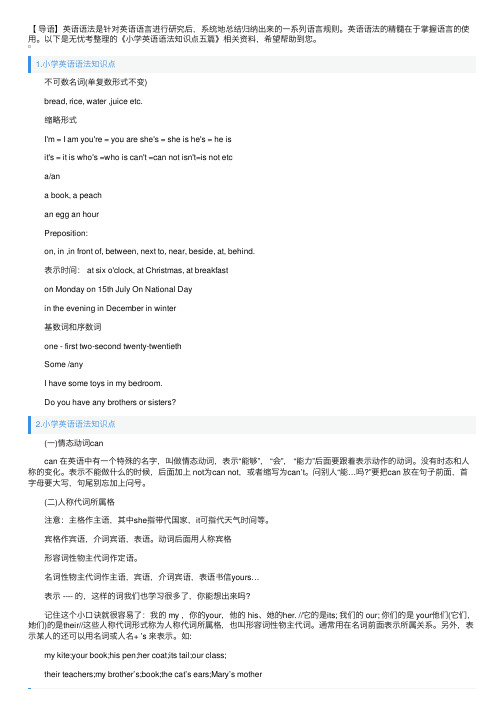
【导语】英语语法是针对英语语⾔进⾏研究后,系统地总结归纳出来的⼀系列语⾔规则。
英语语法的精髓在于掌握语⾔的使⽤。
以下是⽆忧考整理的《⼩学英语语法知识点五篇》相关资料,希望帮助到您。
1.⼩学英语语法知识点 不可数名词(单复数形式不变) bread, rice, water ,juice etc. 缩略形式 I'm = I am you're = you are she's = she is he's = he is it's = it is who's =who is can't =can not isn't=is not etc a/an a book, a peach an egg an hour Preposition: on, in ,in front of, between, next to, near, beside, at, behind. 表⽰时间: at six o'clock, at Christmas, at breakfast on Monday on 15th July On National Day in the evening in December in winter 基数词和序数词 one - first two-second twenty-twentieth Some /any I have some toys in my bedroom. Do you have any brothers or sisters?2.⼩学英语语法知识点 (⼀)情态动词can can 在英语中有⼀个特殊的名字,叫做情态动词,表⽰“能够”, “会”, “能⼒”后⾯要跟着表⽰动作的动词。
没有时态和⼈称的变化。
表⽰不能做什么的时候,后⾯加上 not为can not,或者缩写为can’t。
问别⼈“能…吗?”要把can 放在句⼦前⾯,⾸字母要⼤写,句尾别忘加上问号。
(完整版)小学最全英语语法汇总
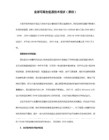
10 页 共 26 页 What (问什么事,什么物或什么工作) What are you doing? I’m reading. What is that? It’s a book. What is she?(What’s her job?) She’s a nurse. What colour(问颜色) What colour is your coat? It’s red. What time(时间) What time is it? What’s the time? It’s seven. when (什么时候) When do you get up? I get up at six thirty. When is your birthday? It’s on the 21st of December. Which(哪一个) Which is your watch, the yellow one or the white one? The yellow is mine. Who(谁) Who is the man with a big nose? He’s my uncle. Whose(谁的) Whose bag is it? Whose is this bag? It’s his bag.
2 页 共 26 页 4. 特殊的 do-does ,have-has, go-goes 2.现在进行时, (1)表示正在发生的动作,通常用“now现在, look看,linsen听”. (2)基本形式: be + 动词ing eg: I am(not) doing my homework. You/We/They are(not) reading. He/She/It is(not) eating. What are you doing? Is he reading? (3)动词的现在分词形式(动词+ing) 一般情况 +ing walk—walking 结尾是不发音的 e -e + ing come—coming 重读闭音节 双写最后一个字母+ing run-running swim-swimming 3. 一般过去时 (1) 表示过去已经发生的事情,通常用 “last …上一个…, just now刚才, a moment ago刚才,
小学英语语法大全(四至六年级)

小学英语语法大全(四至六年级)小学英语语法大全(四至六年级)第一章:基本语法概念1.1 名词定义:名词是表示人、事物、地点或抽象概念的词。
名词是表示人、事物、地点或抽象概念的词。
分类:- 人物名词:boy, girl, teacher, doctor- 地点名词:home, school, park, city- 抽象名词:love, happiness, health, education1.2 冠词定义:冠词是用来修饰名词的词。
冠词是用来修饰名词的词。
分类:- 不定冠词:a, an- 定冠词:the1.3 代词定义:代词是用来代替名词的词。
代词是用来代替名词的词。
分类:- 人称代词:I, you, he, she, it, we, they- 物主代词:my, your, his, her, its, our, their- 反身代词:myself, yourself, himself等1.4 形容词和副词定义:- 形容词:用来修饰名词的词。
- 副词:用来修饰动词、形容词或其他副词的词。
比较级和最高级:- 比较级:表示两个事物之间的比较。
如:bigger, smaller- 最高级:表示多个事物中的最高或最低。
如:biggest, smallest 第二章:动词2.1 动词的分类- 行为动词:run, jump, read, write- 状态动词:be, have, exist- 助动词:do, does, did, can, may, shall, will2.2 动词的时态- 现在时:表示现在或经常发生的事。
如:I read a book.- 过去时:表示过去发生的事。
如:I read a book yesterday.- 将来时:表示将来会发生的的事。
如:I will read a book tomorrow.第三章:句子结构3.1 简单句简单句是由一个主语和一个谓语构成的句子。
如:The cat sleeps.3.2 复合句复合句是由两个或两个以上的简单句合并而成的句子。
小学生语法知识点归纳大全

小学生语法知识点归纳大全一、名词(Noun)名词是指人、事物、地方等具体或抽象的东西。
1. 可数名词(Countable Noun):可以用数目来计算的名词,例如:book(书),dog(狗)。
2. 不可数名词(Uncountable Noun):无法用数目来计算的名词,例如:water(水),information(信息)。
二、代词(Pronoun)代词用来替代名词,可以指代主语、宾语、或其他句子成分。
1. 人称代词(Personal Pronoun):表示人的代词,例如:he(他),she(她)。
2. 物主代词(Possessive Pronoun):表示所有关系的代词,例如:his(他的),her(她的)。
3. 指示代词(Demonstrative Pronoun):指示特定人或物的代词,例如:this(这个),that(那个)。
三、动词(Verb)动词表示动作或状态。
1. 及物动词(Transitive Verb):需要接受动作的宾语的动词,例如:eat(吃),read(读)。
2. 不及物动词(Intransitive Verb):不需要宾语的动词,例如:run (跑),sleep(睡觉)。
3. 连系动词(Linking Verb):连接主语与表语的动词,例如:be (是),seem(似乎)。
四、形容词(Adjective)形容词用来描述名词或代词。
1. 基本形容词(Basic Adjective):直接描述名词的形容词,例如:happy(快乐),bright(明亮)。
2. 比较级形容词(Comparative Adjective):用来比较两个或多个事物的形容词,例如:taller(更高的),faster(更快的)。
3. 最高级形容词(Superlative Adjective):用来比较三个或三个以上事物中最高级的形容词,例如:tallest(最高的),fastest(最快的)。
五、副词(Adverb)副词用来修饰动词、形容词、或其他副词,表示时间、地点、方式等。
(完整版)小学英语语法总结全集
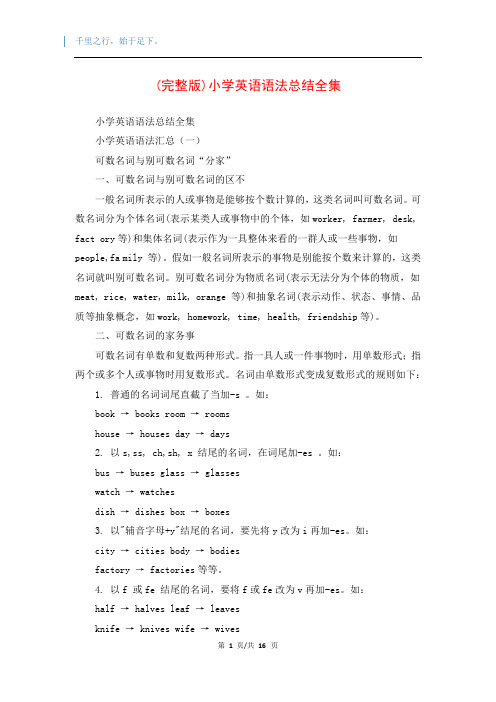
(完整版)小学英语语法总结全集小学英语语法总结全集小学英语语法汇总(一)可数名词与别可数名词“分家”一、可数名词与别可数名词的区不一般名词所表示的人或事物是能够按个数计算的,这类名词叫可数名词。
可数名词分为个体名词(表示某类人或事物中的个体,如worker, farmer, desk, fact ory等)和集体名词(表示作为一具整体来看的一群人或一些事物,如people,fa mily 等)。
假如一般名词所表示的事物是别能按个数来计算的,这类名词就叫别可数名词。
别可数名词分为物质名词(表示无法分为个体的物质,如meat, rice, water, milk, orange 等)和抽象名词(表示动作、状态、事情、品质等抽象概念,如work, homework, time, health, friendship等)。
二、可数名词的家务事可数名词有单数和复数两种形式。
指一具人或一件事物时,用单数形式;指两个或多个人或事物时用复数形式。
名词由单数形式变成复数形式的规则如下: 1. 普通的名词词尾直截了当加-s 。
如:book → books room → roomshouse → houses day → days2. 以s,ss, ch,sh, x 结尾的名词,在词尾加-es 。
如:bus → buses glass → glasseswatch → watchesdish → dishes box → boxes3. 以"辅音字母+y"结尾的名词,要先将y改为i再加-es。
如:city → cities body → bodiesfactory → factories等等。
4. 以f 或fe 结尾的名词,要将f或fe改为v再加-es。
如:half → halves leaf → leavesknife → knives wife → wives5. 特例[悄悄话:特例常常考,要记住。
小学英语语法知识点大全总结归纳

小学英语语法知识点大全总结归纳一、名词(Noun)名词是指人、事物、地点、概念等的名称。
它可以作为主语、宾语、定语等在句子中发挥重要作用。
1. 可数名词(Countable Noun):表示可以分为个体进行计数的名词,如dog(狗)、apple(苹果)。
2. 不可数名词(Uncountable Noun):表示不可以分为个体进行计数的名词,如water(水)、rice(米饭)。
3. 特殊名词(Proper Noun):指具体的人、地点、机构等特定的名称,如John(约翰)、London(伦敦)。
二、代词(Pronoun)代词用来代替名词,避免重复使用。
根据其在句子中所起的作用,可分为主格代词、宾格代词、形容词性物主代词、名词性物主代词、反身代词等。
1. 主格代词(Subject Pronoun):用来作为主语的代词,如I(我)、he(他)。
2. 宾格代词(Object Pronoun):用来作为宾语的代词,如me (我)、him(他)。
3. 形容词性物主代词(Possessive Adjective):用来修饰名词的所有权关系,如my(我的)、his(他的)。
4. 名词性物主代词(Possessive Pronoun):用来代替名词所属关系的代词,如mine(我的)、hers(她的)。
5. 反身代词(Reflexive Pronoun):用来表示动作反射到主体本身的代词,如myself(我自己)、himself(他自己)。
三、形容词(Adjective)形容词用来描述和修饰名词,使描述更加准确和生动。
1. 形容词的比较级形式(Comparative Form):用来比较两个事物的性质或程度,如taller(更高的)、more beautiful(更美丽的)。
2. 形容词的最高级形式(Superlative Form):用来比较三个或三个以上事物中的最高性质或程度,如tallest(最高的)、most beautiful (最美丽的)。
小学语法总结全集英语(7篇)

1:“first”是序数词,与“the”相连,解释为第一。
2:像“first,term,world”作为词组出现时前面要加“the”。
3:“all”所有;后面的可数名词用复数形式,be动词用“are”。
4:“any”一些;用在否定句和一般疑问句中,与“some”同义。
“some”用在肯定句中。
5:there be+数词,采用“就近原则”。
6:a map of China 与 a map of the world 要牢记。
7:要用“on the wall”,不能用“in the wall”。
门、窗在墙上才能用“in the wall”。
8:can 后+动词原形。
9:play+the+乐器; play+球类;10:like的用法11:动词变动名词形式方法:A--直接在动词后面+ing形式(大多数)。
B--以不发音的“e”结尾的,要去掉e后再+ing,比如:dancing,making,riding。
C--重读be音节,末尾只有一个辅音,须双写末尾的字母后再+ing,如:running,swimmi ng,sitting,putting。
12:现在进行时的构成:be动词+动词ing形式。
标志:now、look、listen、its time to。
13:现在进行时的一般疑问句 /问--be动词+人称+时态(动词ing)答--Yes,he/She/it is/am/are. No,he/She/it isnt/arent/am not.14:用Are you...? Yes,I am/ we are. No,Im not/We arent.15: 动词后+人称宾格形式.16:一般现在时的构成:第三人称单数(三单)。
要注意:后面的动词+s或es。
特例:have→has do→dose go→goes; 标志:often,usually。
17:有些名词变动词时要变形式,例如:teacher→teach;driver→drive.1.一般现在时一般现在时态中,动词一般用原形。
小学英语语法大全(完整版)

小学英语语法大全(完整版)小学英语语法大全第一章:名词一、定义名词是用来表示人或事物名称的词语。
它可以表示具体的事物,也可以表示抽象的概念。
二、分类1.名词可以根据意义分为普通名词和专有名词。
例如,john是一个学生,其中student是普通名词,而john是专有名词。
普通名词前可以用不定冠词a/an,定冠词the或不加冠词,而专有名词前一般不加冠词。
另外,专有名词的首字母要大写。
2.普通名词又可以分为个体名词、集体名词、物质名词和抽象名词。
其中,个体名词和集体名词是可数名词,而物质名词和抽象名词是不可数名词。
3.专有名词专有名词是用来表示人名、地名、团体、机构、组织等的专有名词,多数情况下是独一无二的。
三、名词的数1、名词可以分为可数名词和不可数名词。
可数名词——可以数的名词不可数名词——数不清(没有复数形式)例如:drink(饮料)、milk(牛奶)、tea(茶)、water (水)、orange juice(橙汁)、coke(可乐)、coffee(咖啡)、porridge(粥)、food(食物)、rice(米饭)、bread(面包)、meat(肉类)、fish(鱼)、fruit(水果)、cake (蛋糕)、dumplings(饺子)2、可数名词可以与不定冠词a/an连用,有复数形式。
而不可数名词不能与不定冠词连用,也没有复数形式。
在修饰可数名词时,可以直接使用数词。
而在修饰不可数名词时,需要使用量词。
例如:many+可数名词复数;不可数名词用much/alittle+some/any/a lot of3、不可数名词的数量可以用以下两种方式表示:第一种方式是使用等量词,例如:some、much、a little、a lot of、a bit of、plenty of等。
注意,有些词既可以与可数名词复数连用,也可以与不可数名词连用,例如:plenty of、some、a lot of、lots of、等等。
小学英语语法大全完整版
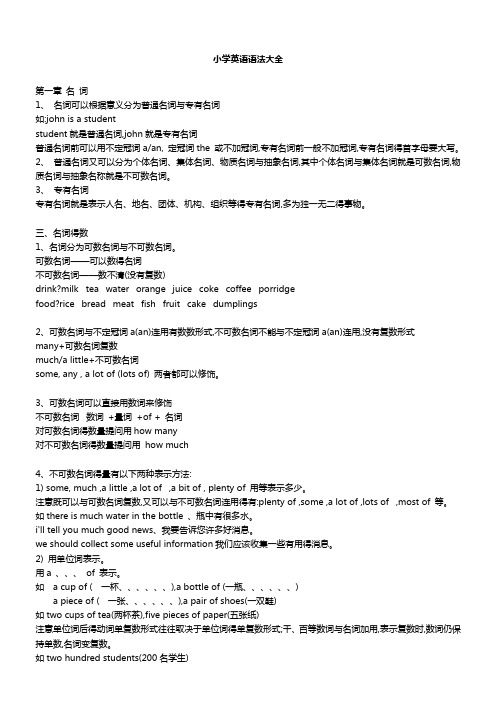
小学英语语法大全第一章名词1、名词可以根据意义分为普通名词与专有名词如:john is a studentstudent就是普通名词,john就是专有名词普通名词前可以用不定冠词a/an, 定冠词the 或不加冠词,专有名词前一般不加冠词,专有名词得首字母要大写。
2、普通名词又可以分为个体名词、集体名词、物质名词与抽象名词,其中个体名词与集体名词就是可数名词,物质名词与抽象名称就是不可数名词。
3、专有名词专有名词就是表示人名、地名、团体、机构、组织等得专有名词,多为独一无二得事物。
三、名词得数1、名词分为可数名词与不可数名词。
可数名词——可以数得名词不可数名词——数不清(没有复数)drink?milk tea water orange juice coke coffee porridgefood?rice bread meat fish fruit cake dumplings2、可数名词与不定冠词a(an)连用有数数形式,不可数名词不能与不定冠词a(an)连用,没有复数形式many+可数名词复数much/a little+不可数名词some, any , a lot of (lots of) 两者都可以修饰。
3、可数名词可以直接用数词来修饰不可数名词数词+量词+of + 名词对可数名词得数量提问用how many对不可数名词得数量提问用how much4、不可数名词得量有以下两种表示方法:1) some, much ,a little ,a lot of ,a bit of , plenty of 用等表示多少。
注意既可以与可数名词复数,又可以与不可数名词连用得有:plenty of ,some ,a lot of ,lots of ,most of 等。
如there is much water in the bottle 、瓶中有很多水。
i'll tell you much good news、我要告诉您许多好消息。
(完整版)小学英语语法大全(完整版)

(完整版)小学英语语法大全(完整版)小学英语语法大全第一章名词一、定义名词是表示人或事物名称的词。
它既可以表示具体的东西,也可以是表示抽象的东西。
二、分类1.名词可以根据意义分为普通名词和专有名词如:john is a student student 是普通名词,john 是专有名词普通名词前可以用不定冠词a/an, 定冠词the 或不加冠词,专有名词前一般不加冠词,专有名词的首字母要大写。
2.普通名词又可以分为个体名词、集体名词、物质名词和抽象名词,其中个体名词与集体名词是可数名词,物质名词和抽象名称是不可数名词。
3.专有名词专有名词是表示人名、地名、团体、机构、组织等的专有名词,多为独一无二的事物。
三、名词的数1、名词分为可数名词和不可数名词。
可数名词——可以数的名词不可数名词——数不清(没有复数)drink?milk tea water orange juice coke coffee porridgefood?rice bread meat fish fruit cake dumplings2、可数名词与不定冠词a(an)连用有数数形式,不可数名词不能与不定冠词a (an)连用,没有复数形式many+可数名词复数much/a little+ 不可数名词some, any , a lot of (lots of)两者都可以修饰。
3、可数名词可以直接用数词来修饰不可数名词数词+量词+of + 名词对可数名词的数量提问用how many 对不可数名词的数量提问用how much4、不可数名词的量有以下两种表示方法:1)some, much ,a little ,a lot of ,a bit of , plenty of 用等表示多少。
注意既可以与可数名词复数,又可以与不可数名词连用的有:plentyof ,some ,a lot of ,lots of ,most of 等。
如there is much water in the bottle . 瓶中有很多水。
小学语文语法知识大全

小学语文语法知识大全一、名词1. 名词的定义名词是表示人、事物、地点、时间、动作和状态的名称的词。
2. 名词的分类名词可以分为专有名词和普通名词两大类,其中专有名词是指特定的人或事物的名称。
普通名词又可分为:物质名词、抽象名词、集体名词等。
3. 名词的数名词有单数和复数两种形式,单数表示一个,复数表示多个。
二、动词1. 动词的定义动词是表示人或事物的动作、变化或存在状态的词语。
2. 动词的时态动词有过去时、现在时和将来时三种时态,分别表示过去、现在和未来发生的动作或状态。
3. 动词的语态动词的语态分为主动语态和被动语态,主动语态表示主语是动作的执行者,被动语态表示主语是动作的承受者。
三、形容词1. 形容词的定义形容词是用来修饰名词或代词的词语,表示人或事物的性质、特征或状态。
2. 形容词的级别形容词有原级、比较级和最高级三种级别,用于表示不同程度的比较。
3. 形容词的位置形容词通常放在名词前面修饰名词,但也可以放在句子的其他位置。
四、副词1. 副词的定义副词是用来修饰动词、形容词或其他副词的词语,表示时间、地点、原因、程度等。
2. 副词的分类副词可以分为时间副词、地点副词、方式副词、程度副词等多种类型。
3. 副词的使用副词通常出现在动词或形容词之前修饰它们,也可以独立成句或连接句子。
五、连词1. 连词的定义连词是用来连接词语、短语或句子的词语,分为并列连词、从属连词和关联词等。
2. 并列连词的使用并列连词用于连接同等重要的词语或句子,表示并列关系。
3. 从属连词的作用从属连词用于引导一个从句,与主句构成因果、条件、时间等关系。
六、介词1. 介词的定义介词是用来表示名词或代词与其他词语之间关系的词语,常出现在名词或代词之前。
2. 常见介词常见的介词有“在、从、往、向、关于、为、到、被、和”等,在句子中扮演着重要的连接作用。
七、助词1. 助词的定义助词是一种没有词义单独使用时要依附于前后词语或完成某些功能的词类。
小学英语语法总结全集

小学英语语法总结全集小学英语语法总结全集一、基本句型1. 主语 + 系动词 + 表语2. 主语 + 动词3. 主语 + 动词 + 宾语4. 主语 + 动词 + 间接宾语 + 直接宾语5. 主语 + 动词 + 宾语 + 宾补6. There be 句型二、动词时态1. 现在时2. 过去时3. 将来时4. 现在进行时5. 过去进行时6. 现在完成时7. 过去完成时8. 将来完成时9. 现在完成进行时10. 过去完成进行时三、名词1. 可数名词2. 不可数名词3. 单数形式4. 复数形式5. 特殊名词的复数形式四、形容词1. 基本形2. 比较级3. 最高级五、副词1. 形容词转换为副词2. 表示方式、时间、频率的副词3. 比较级和最高级的副词形式六、代词1. 主格代词2. 宾格代词3. 物主代词4. 反身代词5. 指示代词6. 疑问代词7. 不定代词七、介词1. 表示位置的介词2. 表示时间的介词3. 表示原因和目的的介词八、连词1. 并列连词2. 选择连词3. 因果连词4. 时间连词5. 让步连词6. 目的连词九、冠词1. 不定冠词2. 定冠词3. 特指用的冠词十、形容词和副词的用法区别十一、固定搭配1. 动词搭配2. 形容词搭配3. 名词搭配以上是小学英语语法的基本知识点总结,针对小学阶段学习英语的学生,这些知识点是非常重要的。
在日常学习和练习中,应该多加复习和巩固,通过大量的练习和实际应用,掌握这些知识点的正确用法,提高语法水平,从而更好地运用英语进行交流和表达。
参考词汇:1. subject [ˈsʌbdʒɪkt] 主语2. verb [vɜrb] 动词3. object [ˈɑbdʒɪkt] 宾语4. complement [ˈkɑmpləmənt] 补语5. countable noun [ˈkaʊntəbəl naʊn] 可数名词6. uncountable noun [ʌnˈkaʊntəbəl naʊn] 不可数名词7. singular form [ˈsɪŋgjələr fɔrm] 单数形式8. plural form [ˈplʊrəl fɔrm] 复数形式9. adjective [ˈædʒəktɪv] 形容词10. adver b [ˈædvɜrb] 副词11. pronoun [ˈproʊnaʊn] 代词12. preposition [ˌprepəˈzɪʃən] 介词13. conjunction [kənˈdʒʌŋkʃən] 连词14. article [ˈɑrtɪkl] 冠词15. phrase [freɪz] 搭配。
- 1、下载文档前请自行甄别文档内容的完整性,平台不提供额外的编辑、内容补充、找答案等附加服务。
- 2、"仅部分预览"的文档,不可在线预览部分如存在完整性等问题,可反馈申请退款(可完整预览的文档不适用该条件!)。
- 3、如文档侵犯您的权益,请联系客服反馈,我们会尽快为您处理(人工客服工作时间:9:00-18:30)。
第一部分词汇专题一.名词单复数变形名词所有格:(1)表示人或其它有生命的东西的名词常在词尾加’s。
如:Children’s Day(儿童节),my sister’s book(我姐姐的书)(2)以s或es结尾的复数名词。
只在词尾加’。
如:Teachers’ Day(教师节)(3)①两人各自的物品,可以采用A’s and B’s的形式,如:Lucy’s and Lily’s bedrooms露西和丽丽的卧室(各自所有)②两人共有某物时,可以采用A and B’s的形式,如:Lucy and Lily’s bedroom露西和丽丽合住的卧室二.代词第一人称:I, we第二人称:you, you第三人称: she, he, it, they三.数词四.介词1.介词是虚词,不能单独使用,有:in, on, under, with, behind, about, near, before, after, for, to, up, down, fro m, in front of, out of等2.表时间的介词:at, before, after, since, still, until, upon, on, from, between, by, in, during, for, through, within, over2, 表地点的:at, form, between, near,beside, by, close to,next to, behind, in front of, ahead of, before, beyond, past3,表工具或媒介:by the means of, with, through4,表内容:over, of, as for, with, due to6,表原因:for, because of, as a result of, owing to, due to五.冠词不定冠词:a、an。
用在单数名词前,表示―一个,一件……。
an用在以元音音素开头的单词前。
如: an e-mail, an orange, an old man, an hour,an apple,an umbrella...a 用语辅音音素开头的单词前,如:a book, a pen定冠词:the用在单数或者复数名词前。
the没有具体意思,有时翻译为这、那。
六.形容词形容词表示某一事物或人的特征七.动词这里所说的动词是指各种动词总称,其中包括be动词、情态动词、助动词、行为动词。
1、be动词( am, is, are, was, were )1)am—was, is –was, are--were 用法:I用am, you和复数用are, 单数用is。
2)肯定和否定句I am (not) from London.He is(not) a teacher.She is(not) in the dining room.My hair is(not) long.Her eyes are(not) small.3)一般疑问句Am I a Chinese? Yes, you are. No, you aren’t.Are they American? Yes, they are. No, they aren’t.Is the cat fat? Yes, it is. No, it isn’t.4)be动词的否定形式:am not(没有缩写形式),are not = aren’t,is not = isn’t。
2、助动词( do, does, did )do, does用于一般现在时,其过去式did用于一般过去时。
它们通常用在疑问句和否定句中。
它们的否定形式:do not = don’t, does not = doesn’t, did not = didn’t。
注意:在一般现在时中,does用于第三人称单数,其余一律用助动词do;助动词do, does, did后面一定要用动词原形。
3、情态动词情态动词也是一类特殊的动词,情态动词可以和行为动词同时出现在同一个句子中。
我们现在学过的情态动词有:can、could、should、will、would、may、might 、must。
注意:情态动词后动词总是用原形。
(不受其他任何条件影响)其否定形式:can not = can’t, must not = mustn’t,could not=couldn’t4、行为动词就是我们平时上课时说的动词,表示某一动作或行为。
如:sweep、live等。
行为动词我们已学过它们的四种形式:原形、第三人称单数+s/es、现在分词(也叫动名词)+ing、过去式+ed。
第二部分句子类型否定句:表示某一否定意思。
句中一定有not。
有三种可能:be动词(am、is、are、was、were)+not、情态动词(can、must、should)+not、助动词(do、does、did)+not如何将一个肯定的陈述句改为否定句:1、看句中有无be动词,如有,直接在be动词后+not。
2、看句中有无情态动词,如有,直接在情态动词后+not。
3、如上述二者都没有,就应用助动词+not。
分四个步骤:(1)肯定陈述句中本来是没有助动词的,要加上去,位置在主语(某人或某物)后,动词前。
(2)确定助动词用do、does还是did,根据句中动词,动词是原形的助动词就用do,动词是第三人称单数的助动词就用does,动词用过去式的助动词就有did。
(3)在助动词后加not。
(4)原句中动词假如发生变化就要恢复成原形。
强调一点,有some的要考虑是否要用any。
一般疑问句表示疑问,一般回答只有两种可能Yes,……或No,……句中没有疑问词。
如何将一个肯定的陈述句改为否定句:1、看句中有无be动词,如有,把be动词提到句首即可。
2、看句中有无情态动词,如有,把情态动词提到句首即可。
3、如上述二者都没有,就应把助动提到句首。
分四个步骤:(1)肯定陈述句中本来是没有助动词的,要加上去,位置在主语(某人或某物)后,动词前。
(2)确定助动词用do、does还是did,根据句中动词,动词是原形的助动词就用do,动词是第三人称单数的助动词就用does,动词用过去式的助动词就有did。
(3)把助动词后提到句首。
(4)原句中动词假如发生变化就要恢复成原形。
强调一点,有some的要考虑是否要用any。
祈使句表示请求或命令别人做某事或不要做某事。
肯定祈使句一定是以动词原形开头(有时有please),否定的祈使句一定是don’t加动词原形开头(有时有please)。
把祈使句改为否定句只需在动词前加don’t即可。
感叹句:由感叹词what引导的感叹句。
1.① What+a/an+(形容词)+单数可数名词+主语+谓语!② What+名词词组+主语+谓语!如: What a fine day it is!2. What+(形容词)+可数名词复数或不可数名词+主语+谓语!如: What kind women they are!What nice music it is!由How引导的感叹句。
(how用来修饰形容词、副词或动词。
)1.How+形容词(副词)+主语+谓语!如: How hard the workers are working!How clever the girl is!How quickly the boy is writing!2. How+主语+谓语!如:How time flies! 时光飞逝!注意:1. 当how修饰动词时,动词不跟着感叹词提到主语之前。
如: How fast the runner runs!2. how与what引导的感叹句中的第一种格式(单数名词)一般情况下可以相互转换,转换后意义不变。
如: What an interesting story it is! = How interesting the story is! What a beautiful building it is! = How beautiful the building is!3. 在口语中,感叹句的主语和谓语常常省略。
如: What a nice present!(省略it is)How disappointed!(省略she is或其它可作本句主、谓的词语)第三部分时态1、一般现在时A、当谓语是be动词时,构成为:主语+be动词( am, is, are )+其他。
如:I am a student.B、当谓语是行为动词时,构成有两种:(1)主语(非第三人称单数)+动词原形+其他。
如:We often watch TV at the weekends.(2)主语(第三人称单数)+动词第三人称单数形式+其他。
如:Jim usually goes to the park on Sundays. C、句型变换:肯定句否定句一般疑问句及回答2、现在进行时A、构成形式:主语+be动词+动词的ing形式+其他。
B、判断依据:句中往往有now、look、listen等词。
注意:千万不要忘了一定得有be动词。
C、句型变换:3.一般过去时A、构成形式:主语+动词的过去式+其他。
注意:没有be动词的否定句和疑问句中,用didn’t否定和用did提问后,动词一定要用原形。
B、判断依据:(1)be动词是was、were;(2)动词加ed;(3)有表示过去的时间状语,现在学过的常用的表示过去的时间状语有:just now,a moment,yesterday,last week,last night,last weekend,last year,last month,three days ago,two weeks ago,five years ago…C、句型变换:4、一般将来时A、构成形式:(1)主语+be going to+动词原形+其他。
(2)主语+will+动词原形+其他。
B、判断依据:一个句子中既有be动词,又有going、to和动词,且动词用的是原形,句中往往有tomorrow、soon、next week等词。
C、句型变换:。
